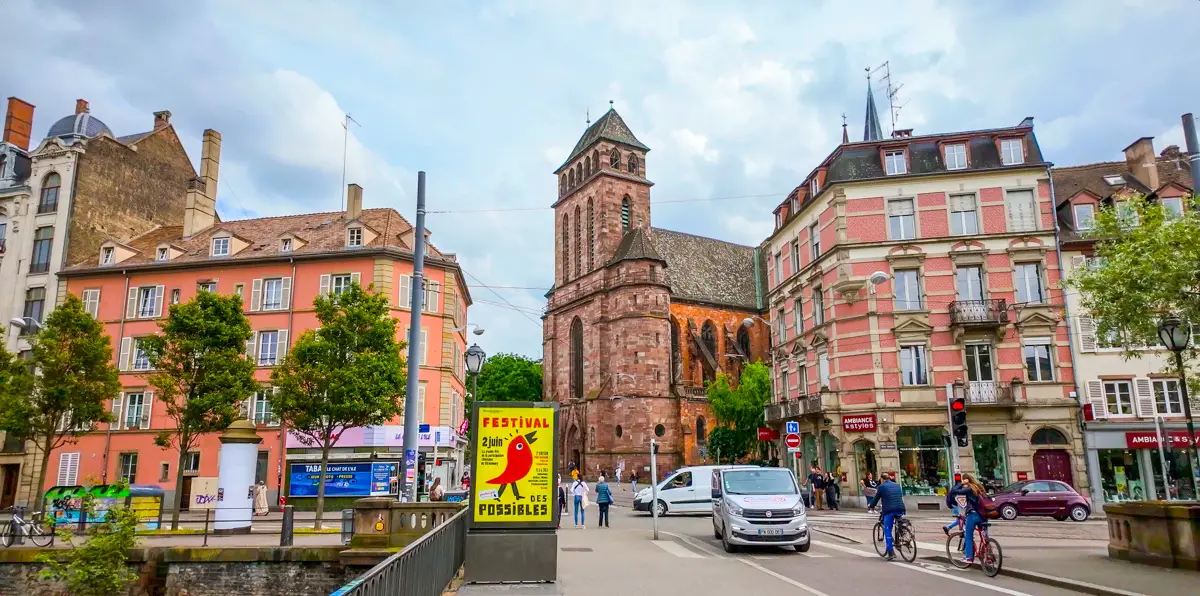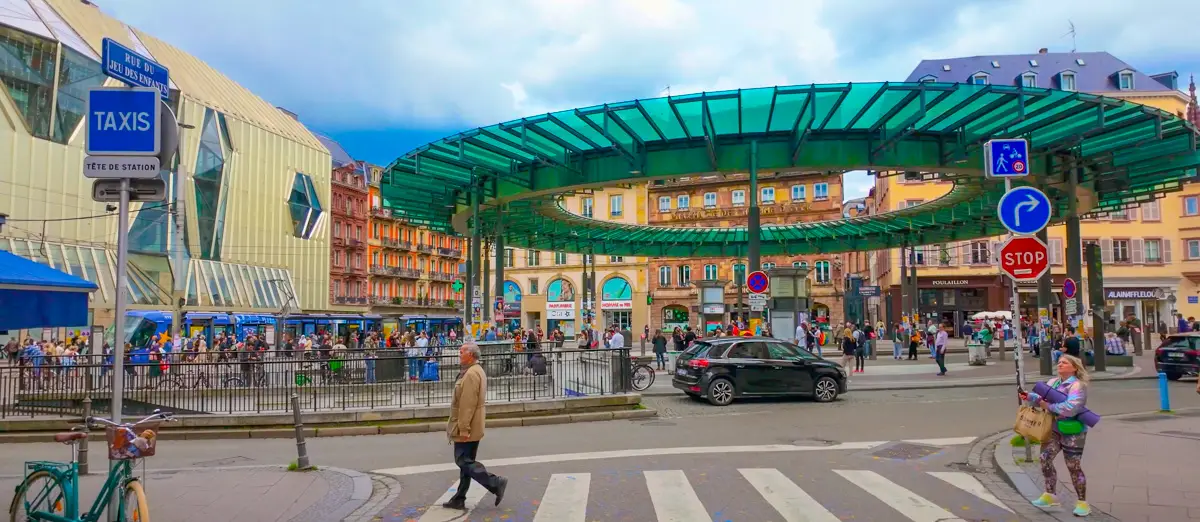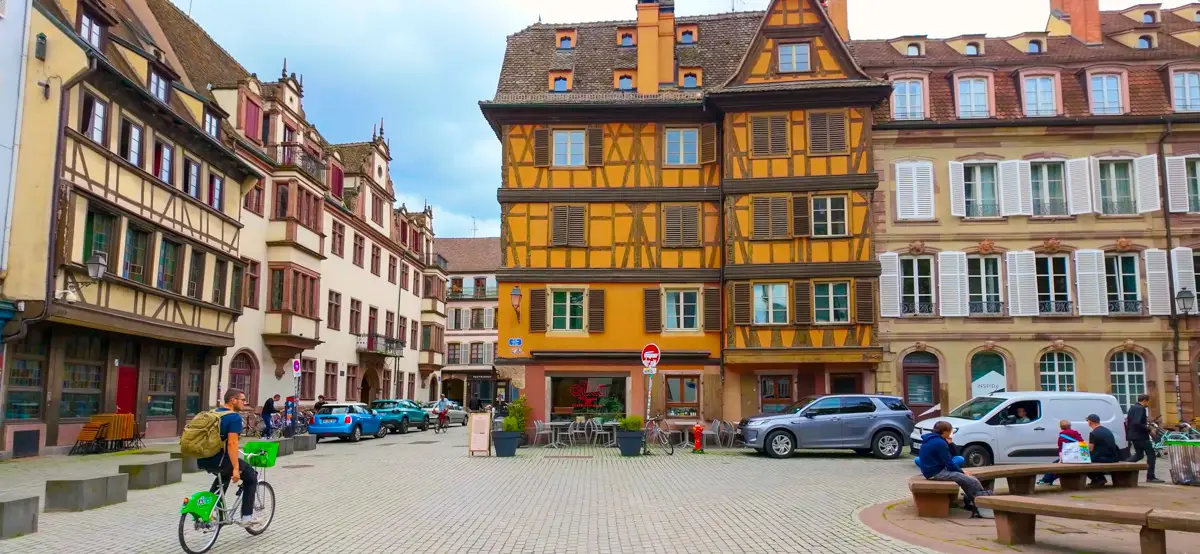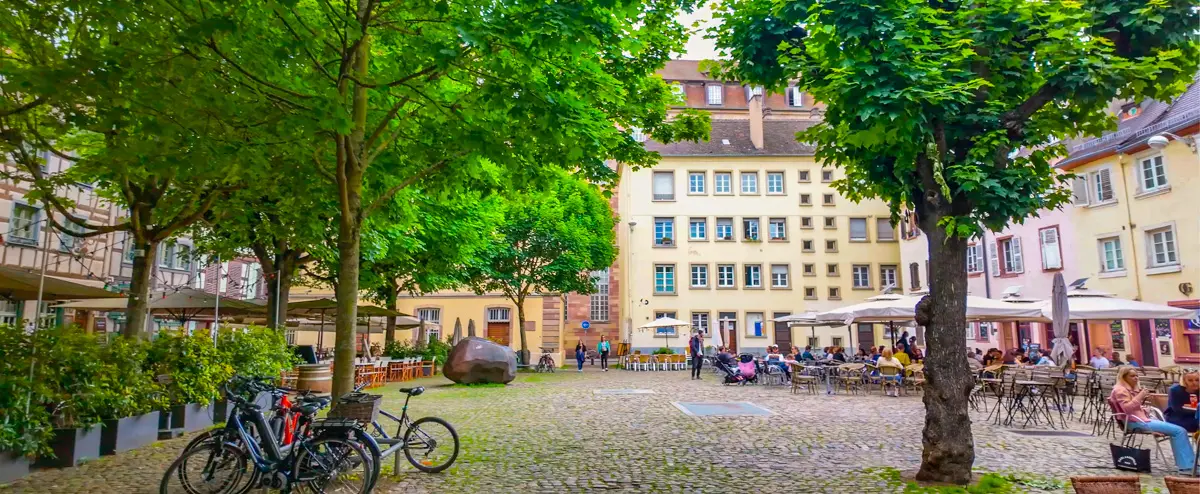Strasbourg, France leads us on a wonderful free virtual walking tours.
Strasbourg Video Tour for Treadmill
FRANCE TOUR: Strasbourg Virtual Vacation Walking Tour

I had time to take a second walk exploring more of Strasbourg, France. The rain clouds were threatening but they held off until later.
I start off not far from where the previous walk ends but a half block closer to the train station. We cross over one of the canals that Strasbourg has made famous and head left down quiet streets with shops and cafes.

After not too long I find a mid century modern style bus station (or maybe a couple decades newer) with a couple of modern buildings thrown in. I find them to be a bit anachronistic amongst all the ancient buildings of the city. From there I take you further north along some other canals and the river, where we see freight boats and more sizeable medieval buildings across the water.

I quickly turn back in towards the residential and historic area and show you more medieval buildings and some quiet little “Places” with trees and cafes including one that is virtually hidden. I actually came back here later to meet my son and we sat under the umbrellas while the rain flooded the cobblestones.
Finally we end up back at the Cathedral where we started the first Strasbourg virtual walk.

More France Virtual Walks from our EuroVelo 6 Bike Tour
Saint Nazaire, France Virtual Walk
Nantes, France City Walk
Nantes, France 2nd Virtual Walking Tour
Angers, France – Rainy Virtual Walk for Treadmill
Poitiers, France Walking Video for Treadmill
Tours, France Virtual Walking Tour
Tours, France 2nd City Walk
Blois, France Walking Tour for Treadmill
Orleans, France Walking Tour for Treadmill
Walking Through Nevers, France
Discover Dole, France – A Virtual Treadmill Walk
Walking Around Besançon, France
Walking Through Basel, Switzerland
Colmar France Treadmill Scenery
Strasbourg France Virtual City Walks
Exploring Bayeux France – Virtual City Walks
More Walking Tours in France:
Aix-en-Provence, France – Walking through Impressionist France
Marseille, France – Ancient City in the South of France
Hyeres, France – Walking in the South of France
Paris, France – Sacre Coeur to Notre Dame – virtual walking travel tour
Paris, France – Inside Notre Dame Cathedral
Paris, France – Notre Dame to Eiffel Tower
Wikipedia:
Strasbourg is at the border with Germany in the historic region of Alsace. It is the prefecture of the Bas-Rhin department and the official seat of the European Parliament.
The city has about three hundred thousand inhabitants, and together Greater Strasbourg and the Arrondissement of Strasbourg have over five hundred thousand. Strasbourg’s metropolitan area had a population of 860,744 in 2020, making it the eighth-largest metro area in France and home to 14% of the Grand Est region’s inhabitants. The transnational Eurodistrict Strasbourg-Ortenau had a population of roughly 1,000,000 in 2022. Strasbourg is one of the de facto four main capitals of the European Union (alongside Brussels, Luxembourg and Frankfurt), as it is the seat of several European institutions, such as the European Parliament, the Eurocorps and the European Ombudsman of the European Union. An organization separate from the European Union, the Council of Europe is also located in the city.
The Roman camp of Argentoratum was first mentioned in 12 BCE; the city of Strasbourg which grew from it celebrated its 2,000th anniversary in 1988. The fertile area in the Upper Rhine Plain between the rivers Ill and Rhine had already been populated since the Middle Paleolithic.
Between 362 and 1262, Strasbourg was governed by the bishops of Strasbourg; their rule was reinforced in 873 and then more in 982. In 1262, the citizens violently rebelled against the bishop’s rule (Battle of Hausbergen) and Strasbourg became a free imperial city. It became a French city in 1681, after the conquest of Alsace by the armies of Louis XIV. In 1871, after the Franco-Prussian War, the city, as part of the Imperial Territory of Alsace–Lorraine, became German again, until 1918 (end of World War I), when it reverted to France. Strasbourg was captured by the German army in June 1940 at the end of the Battle of France (World War II), and subsequently came under German control again through formal annexation into the Gau Baden-Elsaß; since the liberation of the city by the 2nd French Armoured Division under General Leclerc in November 1944, it has again been a French city. In 2016, Strasbourg was promoted from capital of Alsace to capital of Grand Est.
Strasbourg played an important part in the Protestant Reformation, with personalities such as John Calvin, Martin Bucer, Wolfgang Capito, Matthew and Katharina Zell, but also in other aspects of Christianity such as German mysticism, with Johannes Tauler, Pietism, with Philipp Spener, and Reverence for Life, with Albert Schweitzer. Delegates from the city took part in the Protestation at Speyer. It was also one of the first centres of the printing industry with pioneers such as Johannes Gutenberg, Johannes Mentelin, and Heinrich Eggestein. Among the darkest periods in the city’s long history were the years 1349 (Strasbourg massacre), 1518 (Dancing plague), 1793 (Reign of Terror), 1870 (Siege of Strasbourg) and the years 1940–1944 with the Nazi occupation (atrocities such as the Jewish skull collection) and the British and American bombing raids. Some other notable dates were the years 357 (Battle of Argentoratum), 842 (Oaths of Strasbourg), 1538 (establishment of the university), 1605 (world’s first newspaper printed by Johann Carolus), 1792 (La Marseillaise), and 1889 (pancreatic origin of diabetes discovered by Minkowski and Von Mering).
Strasbourg has been the seat of European institutions since 1949: first of the International Commission on Civil Status and of the Council of Europe, later of the European Parliament, of the European Science Foundation, of Eurocorps, and others as well.
Support us for just $5 on Patreon
Or make a one time Paypal Donation
